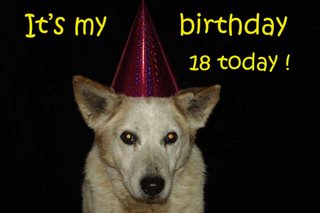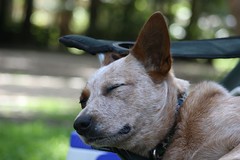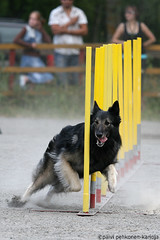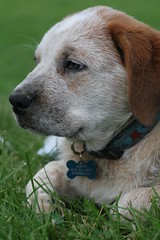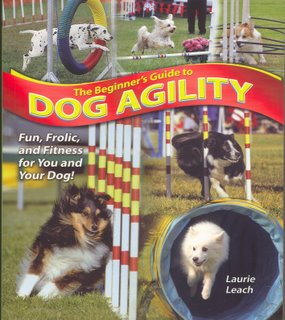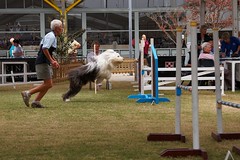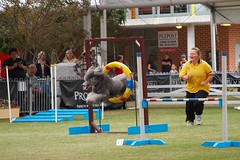
December 09, 2006
Following directions

November 30, 2006
Agility hiatus
She is now fit and well - if still fairly bald in patches - so we will be starting training again.
We have signed up for both of Keith and Le's Summer Camps at Canine Fun Sports. The first camp is on distance handling and the second on games strategies - both looking at how to get your dog around the course fast and efficiently. At both camps there is an opportunity for individual lessons, and mock trials. The camps are always great fun and we learn a lot from having the extended period of training.
November 08, 2006
Video Ref
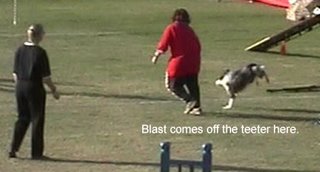
November 06, 2006
Training With Mental Telepathy

November 03, 2006
October 31, 2006
Dusty's semi-siblings

October 29, 2006
October 27, 2006
Obstacle names
- Dog Walk - Dog walk, cat walk, walk it, walk on, walk up, plank.
- A-Frame - Scramble, climb, mountain, charge, wall.
- Teeter - Teeter, see saw, tip it, careful.
- Table - Table, place, rest, park it, get on.
- Tire - Tire, circle, middle, hoop, ring.
- Tunnel - Tunnel, through, zoom.
- Chute - Chute, tunnel, through, push, gogogo.
- Jumps - Jump, hup, over, get up.
- Spread jumps -Hup hup, jump, over, big jump, big hup, big over, big.
- Weaves - Weave, poles, weavies, wiggle, snakie, in-out, zig-zag, boogie.
- Contacts - Get it, bottom, spot, touch, wait, easy.
October 26, 2006
Wet Dog
The Dog
The truth I do not stretch or shove
When I state that the dog is full of love.
I've also found, by actual test,
A wet dog is the lovingest.
My dogs end up in the water most days, so I have a regular towelling off routine before they hop in the car - if there are still dog towels in the car, and if I'm quick enough to grab them both before they jump in, or if I could be bothered to take the time and don't just shrug it off with a "the car needs a clean, anyway."
They shake on command, but that does only so much. I have 'miracle' and 'magic' dog towels but they still have to be vigorously applied to two dogs. So I like the sound of these dog coats - Trover ® Bone Dry . Made and lined with super soft looper fleece, the coats are hydrophilic and dry dog quickly as they wear them. They can also be put on wet, as a cool coat in hot weather.
Put the coat on, and the upholstery is protected while the coat drys the dog on the way home. Now that is magic.
October 25, 2006
Victoria Stilwell
From a review by Aerial Telly:
The philosopher Michel Foucault wrote that the techniques perfected in the penal system were transmitted through to wider society via "the carceral archipelago" creating a whole society of docile bodies submitting to the will of the state.
What I believe the baldy turd was trying to say is that condign discipline is going transnational and is no longer the preserve of prison inmates and pervert businessmen. Spare the rod and spoil the klutz is the mantra and TV is the bludgeon the state is using to break our will.
Supernanny brought toddlers into line, Teenage Brat Camp gave sk8er bois a reason to live and the 'hilariously' misandrist Bring Your Man to Heel showed how your husband could be trained like a dog.
Now we've come full circle and dogs are being treated like husbands - which is to say like dogs. It's Me Or The Dog is the latest in a catalogue of behaviour alteration projects beamed into our homes with the same message - "step out of line and you'll be next, Fido".
Dog trainer Victoria Stilwell is the agent of the state - making house calls on disruptive dogs and straight punking their asses.
You probably know the drill by now - good behaviour is rewarded and bad behaviour is punished. Give the dog more exercise and slap some sense into the owner. And the dog is told to get the fuck off the sofa or get its bollocks cut off.
October 24, 2006
Cavaletti Calculator
The Cavaletti Calculator gives instructions for building portable cavalettis that can be rotated to provide four different jump heights.
October 20, 2006
Thommo at Armidale
Armidale trial

October 18, 2006
Dusty's first trial

October 12, 2006
Learning the Rules
Csanyi set up an experiment in the lab with three groups; children aged 4 to 6, graduate students, and adult dogs. In the room were three large screens. The experimenter would place a ball in a plastic bucket, watched by the participant. He would then go behind each of the screens in turn, putter about for a moment, and emerge to show the participant whether the ball was still in the bucket or not. The he (in the case of the grad students) or the dog's owner, or the children's kindergarten teacher, would give a signal to find the ball. The grad students only made one error, and the dogs and children both had success rates that were much higher than could be achieved at random.
In the next stage of the experiment, the experimenter quite obviously put the ball in his pocket, showed the participant the empty bucket, and then disappeared behind each screen in turn pretending to leave the ball and showing the empty bucket after each.
All three groups had a few smartypants who immediately indicated that the experimenter had the ball in his pocket. But 50% of the grad students, 55% of children, and 75% of the dogs ostentatiously searched behind the screens for the ball before returning to the experimenter.
When the children and students were asked, they said that they felt that searching behind the screens was the essence of the game, regardless of where the ball was. Csanyi says "I see no reason to doubt that the dogs had similar ideas."
This and other experiments showed that dogs can learn the rules through patterning.
The problem is that we are often unaware of what the rule is that the dogs are learning. I think there are some dogs out there who know the rule "Walk up the ramp, across the top, jump off, mum puts me back on, I wait and she gives me a treat."
Morgan Spector said something that I mis-remember but it was like "Once is an aberration, twice is a pattern, three times is a lifestyle."
October 09, 2006
Canine Communication
One day they had been out and Jerry had been given a number of hot dogs at lunch time, so for the evening meal he received a very small portion. Jerry ate this quickly, and then took the appropriately shaped wood to Csanyi asking for something to eat. Not getting any response, he repeated the action several times, then went and lay on the balcony with the wood between his paws.
After a minute or two, he got up, picked up the wood, and dropped it over the side of the balcony.
October 03, 2006
If Dogs Could Talk
Unlike those books that see dogs' evolution from the wolf as a reason for imposing pack hierarchies on pets, Csanyi's research shows that we have created the domestic dog in the course of living with them for tens of thousands of years. In this long process dogs lost many of the characteristics of their wolf ancestors, and in their place gained "the ability to love, a well-developed social intelligence, the human tools of collaboration, and the ability to understand human behaviour."
His experiments suggest that dogs do not see their housemates as a pack, but rather as a team that functions collaboratively.
September 26, 2006
Get Out
September 16, 2006
Agility Vision

The opening sequence caught a lot of handlers by surprise, with many dogs taking the off-course into the tunnel, instead of the left turn to jump 5.
Agility vision has a video of the competitors running the sequence using different handling techniques (Please turn!), an interview with Janet Gaunt, the judge and course designer, interviews with competitors Susan Garrett and Mary Ellen Barry and video of playing around after the Grand Prix where a few handlers (Rachel Sanders, Susan Garrett, Mary Ellen Barry) and the judge, Janet Gaunt, went out on course to try to figure it all out.
You will need to register (its free) to see the videos.
September 11, 2006
Wet weekend
September 08, 2006
Dog's ages
This is not an exact science but Ruby is a lovely old lady in her nineties. Congratulations to her and to Nicola, may they enjoy each others company a while longer.
September 07, 2006
Lead-out Pivot
September 04, 2006
Watching a run.
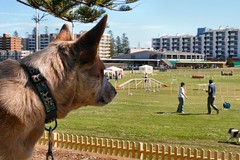
Watching a run.
Originally uploaded by marj k.
Dusty is still an agility spectator, though she may trial for the first time in October. Here she is watching the events at Port Macquarie.
August 21, 2006
Lead-out
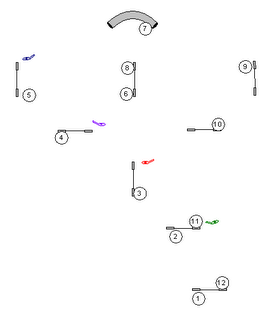
Thommo has a great start-line wait, but we don't use it very often as he is much more motivated if I run with him. There are not a lot of courses where a lead-out gives a significant advantage, and I often see handlers leading out huge distances and then waiting for their dog to catch up before running together. However, Dusty doesn't need the same support at the start-line, and her speed could require strategic positioning on course to give her early warning of the path, so we are back practicing lead-outs. This exercise alternates lead-outs and lead-out pivots.
Lead-out – A handling maneuver where the dog is placed on a wait at the start line and the handler moves to a strategic position prior to starting the course.
Lead-out pivot – A maneuver used to change a dog’s direction off the start line. The handler leads out, faces the direction he initially wants the dog to go, and then calls the dog. As the dog lands, the handler counter-rotates 270° to effect a change of side and change of direction.
August 16, 2006
Conditioning
Conditioning is defined as "developing a state of health, readiness, or physical fitness." Simply stated, conditioning consists of a planned program of exercise. Fitness is the condition of being physically fit. Fitness includes, cardiovascular, muscle strength, muscle endurance, power, balance, proprioception, flexibility and more.
Specific Training For Your Sport
Mimic the movements of your sport in your conditioning program. For example, if you do a 2 on 2 off 6’3’ A Frame, you need to strengthen those muscles in that specific position without the impact of that obstacle.
Cross Training
Get your cardiovascular workout or strength training using different muscles than you use for your sport in order to prevent overuse injuries. For example, swimming your agility dog.
The article goes on to list the pros and cons of a number of popular methods of exercising dogs, such as:
Johnson advises against throwing a ball as a form of exercise:
Too focused on ball, therefore, runs into fences, cars, other dogs, people and other objects
Too focused on ball, therefore not thinking about their body position & landing
Jumping high into air, causes big uncontrolled impact on landing, high risk for injury
Running after low ball is high risk for impact sliding injuries
If the dog is overweight or unfit, the risks are extremely high for injury.
Is this the play relationship you want with your agility dog - pick up a toy and your dog runs out away from you.
August 15, 2006
Environmental rewards
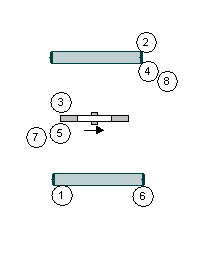
I'm looking to reward Thommo with things that he likes to do, rather than with toys or treats, as a way of keeping him 'in the game'. These two exercises we'll work on over the next few days, using the tunnel as a reward for a fast teeter and/or a tight turn, and as a reward for control on the table.

Tunnel entries

At training with Le and Keith - Canine Fun Sports - today we did an exercise practicing entries to the far end of the tunnel. We tried a range of strategies: using a front cross, a call and send, an off-arm turn. Thommo was not in the mood so had to be coaxed and jollied through the exercises - it makes it hard when he's not driving to the next obstacle. Dusty was so driven that I was stretched to get into place for the move I wanted.
In her class we also did some see-saw work. Keith stepped up to control the drop and Duz turned to look and fell off the side. She immediately hopped back up in the same place and continued to the end for her treat.
July 22, 2006
Field Work
Another herder I know had the misfortune of running her dog on a clear, crisp morning when the dog was more than a little fresh. In fact, "wired" would probably be a better description. After starting the outrun barely under control, her dog in a fit of total joie de vivre burst through the herd of sheep which, in turn, set up a wild run. Delighted at the opportunity, the dog tore after the sheep and turned them right back at her handler with the sheep on a dead run. The handler disappeared under a sea of sheep which meant the dog could no longer see the human she was fetching the sheep to. So, she proceeded to circle at top speed tightening the sheep over the prone body of her handler. Making the incident that much more humiliating, friends, and in this case that word should be used advisedly, videotaped the entire show. On the video, every now and then a hand appears from the depth of the sheep whirlpool and faint cries of "lie down," fortunately without the expletives, can be heard on the audio portion of the tape. The handler says she never did get all the stains out of her clothing and the black-and-blue marks on her body, all in the shape of a sheep hoof-print, were quite spectacular for days after the event.
July 19, 2006
July 14, 2006
July 13, 2006
Camping
 The camo sleeping-bag is available from ForDogs They also have dog tents and folding food tables.
The camo sleeping-bag is available from ForDogs They also have dog tents and folding food tables.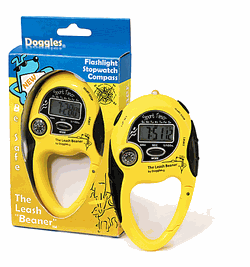 For the serious dog hiker Tails by the Bay have the Leash Beaner, a carabiner clip-on for your leash that has a built in compass, stop watch, watch, and mini flashlight.
For the serious dog hiker Tails by the Bay have the Leash Beaner, a carabiner clip-on for your leash that has a built in compass, stop watch, watch, and mini flashlight.Other suppliers:
July 12, 2006
This girl ...
At 15 months Dusty begins her first 'season'.
Stages of the Estrous Cycle
- Proestrus: Vulvar swelling and bloody vaginal discharge marks the beginning of proestrus.The first day of bleeding is called the first day of heat. The duration of proestrus can vary from as little as 1 day to 21 days. Proestrus is a time of rising estrogen levels preparing the reproductive tract for breeding.
- Estrus: Is the period of receptivity. Behaviorally it begins the first day the bitch stands. Hormonally it begins on the day of the LH (LueteinizingHormone) surge and is marked by rising progesterone levels and decreasing estrogen levels.
- Diestrus: Normally begins 7 to 9 days post the actual LH surge. Progesterone levels continue to rise and the vaginal cytology cornification abruptly declines. The diestrus period lasts until the bitch whelps or the serum progesterone returns to a basal level.
- Anestrus: Is the period of time between the end of diestrus and the next proestrus period.
The season can last anywhere from 5 days to 3 weeks. I'm hoping for 5 days.
June 28, 2006
Body Language
Eyes - Your dog is aware of where you are looking, look at the obstacle you want him to perform next.
Shoulders - They are a powerful communication tool. A turn of the shoulders indicates a change of direction, and the degree of rotation tells how sharp the turn will be. A drop of one shoulder is a cue that the handler is going to rear cross, or cross behind the dog.
Arms - There are three basic ways to use your arms, all arm signals are given with the arm closest to the dog. Bowling the dog is where, palm up, you swing the arm towards the next obstacle. Drawing a path is where you point with one finger moving your arm to show the dog the correct path to the next obstacle, so your arm is close to your body if your dog is to stay close to you, and your arm is outstretched if your dog is to stay further away. Pushing is using an open palm and a push motion to widen the dog's path away from you.
Feet - Dogs, particularly small dogs, learn to read your feet like the arrow on a compass. Your feet should face the next obstacle as soon as possible.
Position - Your position in relation to the dog also tells it where it is to go on course. Lead outs and front and rear crosses give precise information about where the dog is to go next.
June 26, 2006
Starters Agility

At an ADAA training camp on the weekend Dusty ran her first full length course. She wasn't really up to this step, but handled it well apart from a tendency to run over to me after every few obstacles. She had lovely contacts, dropping and waiting for the release, and quick responses to the front crosses and post turn. We haven't started training the weaves so I called her past them to the tunnel.
June 23, 2006
Bongo - RSPCA

IMG_1183
Originally uploaded by marj k.
Partly out of guilt at buying myself such an expensive toy, I'm using the new camera to photograph dogs and cats at the local RSPCA shelter, so that they can publicise re-homable animals on their website. So many wonderful pets - they don't have issues or problems, just got too big or too active, or became inconvenient.
I adore Dusty, and needed a 'well bred' dog after the heartbreak of losing Diesel - and Duz shows her good breeding in so many ways - but my next dog will be a rescue.
I almost shook a woman at the dog beach today who was telling me that her reason for breeding her labrador (to a neighbour's lab, no health checks anywhere) was that if she throws back to her chocolate lab mother, the puppies will be 'worth quite a bit'.
Stock Handling
Wombramurra Station near Nundle in NSW looked good, with flexible packages including a 'work for your board' option, however despite its great web site, the contact numbers don't work and it looks like it might have changed hands.
Cruickshank's is a bed and breakfast on a sheep property near where I go for herding lessons, it might be possible to negotiate some work experience.
Leconfield offers a Jillaroo/Jackaroo school, which teaches a whole range of skills I have limited use for such as shoeing a horse and building bush furniture, but they cover stock handling.
Jim Lindsay of LSS runs schools that teach Low Stress Stockhandling, delevoping an attitude that promotes harmony between man and animal. "We can put ourselves in a position to be able to consider the situation from an animal's point of view and therefore have an obligation to do so. When we have knowledge of how an animal reacts to different situations we can use that information to effect. Being an effective stockhandler is about knowledge, understanding, attitude and patience.
Working Dog Schools cover the basic fundamentals of working a herding dog. Herding dogs are those that instinctively have a desire to go around their stock and keep the stock together and bring them back to the handler. The schools are designed to give the handler an insight into how working dogs think and want to operate. The most important thing in a working dog is to have a desire to work. When that is established the handler must understand how to control that desire. Heavy emphasis is placed on letting the dog work as naturally as it wants in order to get the job done. Sometimes this takes a considerable amount of understanding on behalf of the handler. Understanding this process and putting it into practice can be very rewarding."
June 20, 2006
Zen and the art of herding

Robert starts the session by asking where you are at, and what you want to achieve. I said I was looking for some sort of herding zen - a state of acceptance and peace that involved sheep and wilful red cattle dogs.
Dusty standing, loose leashed, watching the sheep a couple of feet away was a big start.
Soft Start
Not too much was asked of us the clinic last weekend. I worked on trying to read Dusty and the sheep, anticipating what they were going to do, and her response to them, trying to get myself in the best place to let her do what she knew she had to do.
I know trust is a big part of it - trusting that she has good instincts and has been taught well and then just giving her freedom to do her job. I was about to give up herding, I was worried about my inability to be in control at all times but I think I now understand that I don't have to be.
If you get a chance to go to a Robert Cox clinic, do yourself a favour. He is as good at reading people as he is at reading dogs and sheep.
June 14, 2006
Weekend Results
Dusty coped with very trying conditions and ratty sheep to get two passes in her Herding Tests to earn her HT. After her second test I took them out to a open space and she literally had the zoomies, racing around in big circles through bushes and across the not-quite dry dam. Apparently she was exhibiting more self control in the ring than I had given her credit for.
Best of all they both snuggled up to me in the tent, alleviating the deficiencies of my mild-weather-only sleeping bag.
June 13, 2006
The sun
June 06, 2006
Training
May 28, 2006
My Greyhound
May 27, 2006
"Get out" command

Over the last few days we have been working on a cue for Dusty (and Thommo) to move away from me. We'll use it in herding to give a soft start, and in agility for distance work.
First step. I set up two short fences using garden mesh, with a gap between them so that I could go straight ahead. I put a target out in front of the gap, blocked the gap with my body and sent Dusty to the left. I stepped through the gap, to reward her at the target. Repeated left and right. I'm using a movement of my arm away from my side as a signal. No verbal cue as yet, but will just use a "Sssht" when we are with the sheep.
Second step. Duz likes to herd the yard broom, so I've been sending her around the end of the fence while I sweep straight up the middle.
Third step. For the two of them I put a jump at the end of the fence sending them out to do the jump while I run through the gap and up the middle. I'll add more obstacles to the line as they get the idea. Thommo is pretty good at this and we have a few Gambler's titles, but I don't think it hurts for him to go back to babysteps with Dusty. The arm movement is the only signal as yet for Dusty, for Thommo I use "out" as well.
May 26, 2006
Herding 101
May 22, 2006
My way or the highway
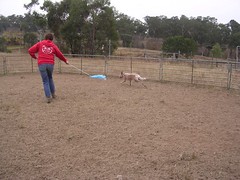
DSCN1991
Originally uploaded by trent shepherd.
Trent captured Dusty and I discussing how we were going to handle the flock - left up to her she would only go anticlockwise.
May 20, 2006
Sheepdog
May 19, 2006
Strategic Pairs
In our practice example, we decided that dog one would do obstacles 1 to 3, dog two 4 to 7, then dog one 8 to 10, and so on. As it turned out dog one had the obstacles that would be most likely to cause problems, and dog two had the trickier course sections.
Thommo did well. We were too quick starting our section and had to re-do the first obstacle, but I never mind Thommo being too quick. With strategic pairs I have to be careful that he doesn't see call offs or stopping him running or making him wait as corrections or he gets depressed.
After two runs our instructor said we were finished so I put Thommo away and got Dusty out for her class. But we got through the next turn quickly and were able to have another go. So I let Dusty have a run. She really responded to the excitement, handled all the obstacles without fault and raced around her sections. We had one run past on a sharp turn, but that was my fault. I was impressed, she is not really up to running courses.
May 18, 2006
Stick games
May 13, 2006
May 11, 2006
Agility class
Some of the sequences were harder than others. The jump tunnel jump got quite a few dogs running past the tunnel opening. As Le explained it there were four reasons for this:
- People got caught behind the wing of the jump, and in stepping around it pulled their dog to the right and away from the entry.
- People were behind their dog at the jump and the dog turned back towards them missing the entry.
- People turned too soon, dropping their left arm before the dog had committed to the entry.
- The tunnel curved to the left, away from where the dogs knew the reward was.
Once we had sorted out our handler paths and body language even the young dogs had no problem with the sequence.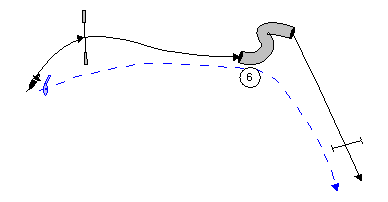
Canine Behavioral Assessment
The researchers at the Center for the Interaction of Animals and Society of the University of Pennsylvania have developed a test to assess canine behaviour and flag any attributes which could be cause for concern.
The test consists of 101 questions describing the different ways in which dogs typically respond to common events, situations, and stimuli in their environment. Users simply click a box to indicate the extent to which the description fits their dog. It takes 10 to 15 minutes to complete.
It is designed to be used by veterinarians, behavioral consultants, researchers, shelters, and working dog organizations with an interest in screening dogs for the presence and severity of behavioral problems. For a limited period, it is also open pet-owners interested in comparing their dogs to others in the database.
The dog is scored in the following categories:
- Stranger-directed aggression
- Owner-directed aggression
- Dog-directed aggression/fear
- Familiar dog aggression
- Trainability
- Chasing
- Stranger-directed fear
- Nonsocial fear
- Separation-related problems
- Touch sensitivity
- Excitability
- Attachment/attention-seeking
- Energy
 A gold star indicates that this dog scored within the normal range.
A gold star indicates that this dog scored within the normal range. A red flag indicates that this dog obtained a less favorable score for this subscale than at least 75% of the dogs in the comparison sample.
A red flag indicates that this dog obtained a less favorable score for this subscale than at least 75% of the dogs in the comparison sample. Two red flags indicate that this dog obtained a less favorable score for this subscale than at least 90% of the dogs in the comparison sample.
Two red flags indicate that this dog obtained a less favorable score for this subscale than at least 90% of the dogs in the comparison sample.Canine Behavioral Assessment and Research Questionnaire
May 09, 2006
Agility Equipment
Helix Fairweather in her article Home Schooling Your Clicker Trained Agility Dog quotes Julie Daniels - Agility has three major categories of obstacles and one oddball one: the go-overs, the go-ups and the go-throughs. The go-overs are the various types of jumps — bar jump, tire jump, broad jump, panel jump, spread jumps. The go-ups are the contact obstacles; the A-frame, the dog walk, the teeter, the table. The go-throughs are the tunnel, the chute, the tire jump. The oddball obstacle is the finesse obstacle — the weave poles. So we have been training these skills - go over, go up, go through, weave - using a variety of makeshift, found and cheaply purchased odds and ends.
But with two dogs now doing agility training it might be worth my effort to set up a collection of 'better' equipment so that at least training exercises are more consistent. For example, my found jumps are not height adjustable, so I either set them up for Thommo and put the bar on the ground for Dusty, or I set them up for Dusty and Thommo walks over them.
May 07, 2006
Tracking training
Try Tracking
We went to Medowie State forest, twenty minutes out of Newcastle. Our group consisted of a German Shepherd, a Dachshund, a Border Collie, a Corgi and a Cattle Dog. For the beginners we started with short 15-20 metre tracks, in a straight line laid directly into the wind (which was a very light breeze). The area we were using was level, with knee high grass and sapling regrowth.
With our dog in the hands of another classmate, we each placed a start flag with a sock bearing our scent beside it, and a tasty treat on top of it. We then walked with a normal stride and speed out to the end point where we left another sock and treats and placed our end flag. By looking from flag to flag we then had a line that should approximate the scent trail. We returned to our dogs making a big arc downwind of the track.
The dogs wore their tracking outfits: harnesses, with a two/three metre lead attached. We'll work up to the regulation 10+ metre line. We brought the dog to the start flag, and gave the cue to track. The dogs all ate the first treat without any problem, but most needed some encouragement to continue to follow the trail to the next article. For some the instructor began laying the track and encouraging the dog with a food container. Dusty was great. She had the idea of following my track and stayed on it fairly consistently despite signs of rabbits and kangaroos. We each did four tracks, then sat in the shade to discuss our progress.
I have the book Try Tracking and had read it, and done the first three days of the training plan, so Dusty was a little advanced of the others in our group. Try Tracking's author says that it is important in the early days to do at least three tracks a day, six days a week for the first three weeks to imprint the idea of tracking, so we are going to continue with the lesson plans from the book. Unfortunately tracking class won't be able to meet again until the end of the month.
May 04, 2006
Ready, Steady, Go Game
Get Tuffie to stand, sit or drop facing you, say ‘Go’ and back away presenting a handful of treats in front of his nose or a tug-toy. Don’t say anything other than ‘Go’ and don’t repeat it. Let him 'chase' you three times and end the session.
Next session, extend the time you ask Tuffie to wait before saying ‘Go’. Present the toy or treats after you have said go.
The next session, sit Tuffie off to the side of you facing the same way as you. Crouch into a semi-racing posture, this will be the signal that you are going to run. Ask for the sit, count two bananas, say ‘Go’ take a step or two and hold out the treat.
Over the next days or weeks add duration, waiting a few seconds longer, taking a few more steps before rewarding.
When Tuffie understands the game, before saying ‘Go’ add in a drawn out ‘Steady’ first. Be dramatic, you want to work him up to fever pitch.
Then put a ‘Ready’ and the front. Your goal is to have Tuffie quivering in anticipation as you say ‘Ready, steady’ then take off like a rocket as you say ‘Go’ to race you.
Next step to work towards is for Tuffie to stay as you walk away. At first walk before saying anything, later you can walk away saying 'Ready, steady'. Start with just one step, work up to some metres.
Then remove your body language as a cue. Stand still and straight to say 'Ready, steady, go!' then start running, or throw the toy or treat container.
Now try it in front of a jump, then a line of jumps.
Start line stays
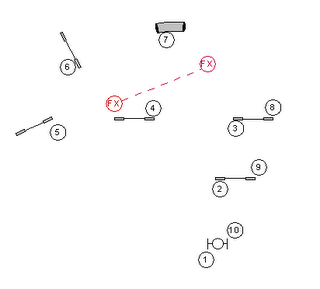
At class last night we worked on tyres and tunnels, neither of which Dusty has any problem with, and on tightening turns, and we did some start-line stay practice.
With Thommo I do a stand stay. This seemed to be the position he was most comfortable with, probably as a result of playing Ready, Set, Go games where he would be standing beside me, and of many hours of him standing and waiting while a threw a ball, then gave the OK to fetch.
With Dusty I'm using a down stay at the start, again because this seems to be a default behaviour for her, and one the first stay we learned as she needed to do a down stay in the presence of sheep to get her Herding Instinct Certificate. I guess I could insist on a sit-stay with either of them, and work to reinforce it and proof it. But why not start from a position they are already comfortable with.
There is some debate over what is the fastest start. Nancy Geyes recommends a sit-stay, saying that she finds it easier to teach a reliable, square, sit-stay, than a stay in a stand or down position. Chris Zink says that dogs that are left standing at the line first trot and then have to shift into a canter before jumping (jumping is an extension of the canter). This wastes some time and also makes it more difficult for the dogs to judge the correct take-off point. In contrast, dogs that are left sitting go straight into a canter and are ready to jump without having to shift into a different gait.
This may be true where the dog stands flat footed, or lies down belly on the ground, but my dogs wait in a sort of crouch: Thommo in a stand slightly lowered, Dusty in a down slightly raised. Most herding dogs adopt this sort of pose in a wait.
Greg Derrett advocates a standing start. He also says to have a routine which incorporates the dog's natural behaviour. He brings the dog to the start line then stands them with a gentle scruff.




